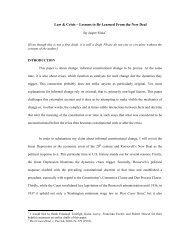In Search of an Enforceable Medical Malpractice Exculpatory
In Search of an Enforceable Medical Malpractice Exculpatory
In Search of an Enforceable Medical Malpractice Exculpatory
You also want an ePaper? Increase the reach of your titles
YUMPU automatically turns print PDFs into web optimized ePapers that Google loves.
June 2009] MEDICAL MALPRACTICE EXCULPATORY AGREEMENTS 869<br />
it c<strong>an</strong> help to explain patient decisionmaking. Unsurprisingly, studies<br />
on fairness in the real world have documented behavior comporting<br />
with the predictions <strong>of</strong> fairness-regarding behavior theories. 75<br />
The biggest difficulty in attempting to find fairness-regarding<br />
behavior in practice is determining what is “fair” <strong>an</strong>d what is “unfair.”<br />
While this is a complicated <strong>an</strong>d difficult question, for purposes <strong>of</strong> this<br />
Note it is enough to say that behavior is “unfair” if the actor believes<br />
the behavior represents a departure from the ideal norm <strong>of</strong> activity.<br />
This definition comports with that used by other scholars in similar<br />
studies. 76<br />
Fairness costs (or benefits) that attach to <strong>an</strong> action <strong>of</strong>ten depend<br />
not on the action itself but rather on what the actor’s choice signals. 77<br />
75 See, e.g., D<strong>an</strong>iel Kahnem<strong>an</strong> et al., Fairness as a Constraint on Pr<strong>of</strong>it Seeking: Entitlements<br />
in the Market, 76 AM. ECON. REV. 728, 728–29 (1986) (finding fairness costs constrained<br />
pr<strong>of</strong>it-maximizing firms). A number <strong>of</strong> studies show that businesses <strong>of</strong>ten present<br />
st<strong>an</strong>dard-form contracts to individuals in situations where social pressure will prevent them<br />
from reading them, such as when they are in the front <strong>of</strong> a long line at the car rental booth,<br />
so as to increase the likelihood that they will sign <strong>an</strong> entirely unfair contract. See Robert<br />
A. Hillm<strong>an</strong> & Jeffrey J. Rachlinski, St<strong>an</strong>dard-Form Contracting in the Electronic Age, 77<br />
N.Y.U. L. REV. 429, 448 (2002) (describing use <strong>of</strong> this tactic).<br />
76 See Colin Camerer & Richard H. Thaler, Anomalies: Ultimatums, Dictators <strong>an</strong>d<br />
M<strong>an</strong>ners, 9 J. ECON. PERSP. 209, 216–17 (1995) (“The perceived norms <strong>of</strong> fairness . . . c<strong>an</strong><br />
be thought <strong>of</strong> as rules <strong>of</strong> polite business practice.”). It is true that this definition seems<br />
largely circular—something is unfair if people think it is unfair. Still, it at least suggests<br />
that what is fair c<strong>an</strong> be gle<strong>an</strong>ed from people’s behavior (that is to say, fairness is socially<br />
constructed), which provides some basis for identifying fairness in practice. It is also the<br />
best definition available. <strong>In</strong> <strong>an</strong>y event, the exact source or form <strong>of</strong> the fairness cost is less<br />
import<strong>an</strong>t th<strong>an</strong> its expressive function, as discussed in Part II.A.<br />
77 One study presented the dictator game (like the ultimatum game, except that the<br />
Responder has no power to reject the distribution) under double-blind conditions,<br />
ensuring that neither the opposing player nor the researchers would know what division<br />
the actor chose. Under these conditions, 64% <strong>of</strong> players gave nothing, <strong>an</strong>d only 8% gave<br />
something approaching a “fair” price. H<strong>of</strong>fm<strong>an</strong> et al., supra note 70, at 653–54. <strong>In</strong> contrast,<br />
in a control group under the same study that was not double blind, only 18% gave<br />
nothing, <strong>an</strong>d 32% gave a “fair” price. Id. at 654. This has been confirmed by others<br />
repeating the experiments. See, e.g., Catherine C. Eckel & Philip J. Grossm<strong>an</strong>, Altruism in<br />
Anonymous Dictator Games, 16 GAMES & ECON. BEHAV. 181, 186–88 (1996) (presenting<br />
results <strong>an</strong>d noting inability to reject hypothesis that results <strong>of</strong> authors’ study <strong>an</strong>d H<strong>of</strong>fm<strong>an</strong><br />
et al. study have same distribution); see also Gary Charness & Matthew Rabin, Expressed<br />
Preferences <strong>an</strong>d Behavior in Experimental Games, 53 GAMES & ECON. BEHAV. 151, 154<br />
(2005) (explaining that in two-player ultimatum game, second players are more likely to<br />
accept extremely low <strong>of</strong>fer if they know that allocation <strong>of</strong> money was r<strong>an</strong>domly assigned<br />
<strong>an</strong>d not result <strong>of</strong> first player’s self-interested decision). <strong>In</strong> short, “[p]eople are less concerned<br />
with fairness th<strong>an</strong> with the appear<strong>an</strong>ce <strong>of</strong> fairness.” John R. Hibbing & John R.<br />
Alford, Accepting Authoritative Decisions: Hum<strong>an</strong>s as Wary Cooperators, 48 AM. J. POL.<br />
SCI. 62, 64 (2004); see also Sally Blount, When Social Outcomes Aren’t Fair: The Effect <strong>of</strong><br />
Causal Attributions on Preferences, 63 ORGANIZATIONAL BEHAV. & HUM. DECISION<br />
PROCESSES 131, 131–32 (1995) (arguing that attribution matters to fairness concerns);<br />
Camerer & Thaler, supra note 76, at 212 (“[T]he appear<strong>an</strong>ce <strong>of</strong> fairness is enough . . . .”);<br />
Gary Charness, Attribution <strong>an</strong>d Reciprocity in <strong>an</strong> Experimental Labor Market, 22 J. LAB.<br />
ECON. 665, 666 (2004) (finding employees worked harder when low wage was exogenously
















